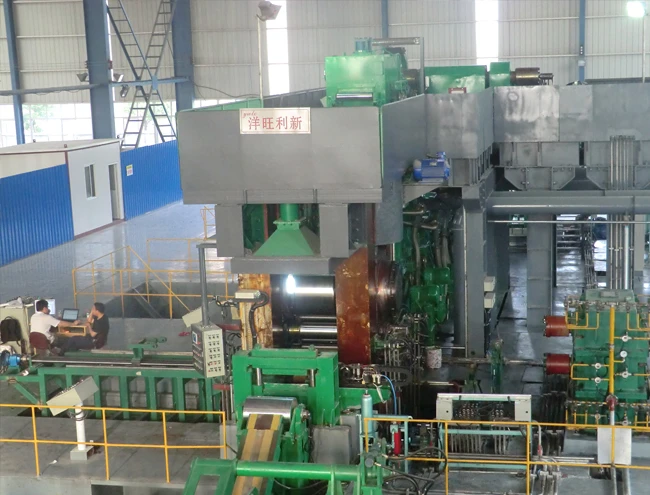
roll bonding cladding-Beijing Yang Wang Li Xin Sci&Tech Co.,Ltd.|Sustainable Metal Composite Solutions&Energy-Efficient Production
The Cladding Rolling Mill represents a breakthrough in metallurgical processing, offering a sustainable and efficient alternative to traditional cladding methods. Developed by Beijing Yang Wang Li Xin Sci&Tech Co.,Ltd., this technology addresses critical challenges in surface quality, energy consumption, and production costs across multiple industries.

Technical Innovations in Cladding Rolling Mill
The roll bonding cladding technology integrated into the Cladding Rolling Mill system utilizes a cold rolling process that fundamentally transforms metal composite manufacturing. This method eliminates the need for post-rolling acid pickling treatment, resulting in superior surface quality. According to NIST research on surface engineering, this approach significantly reduces material degradation during processing.
Key Technical Features
- Surface Quality: Cold rolling prevents oxide formation, eliminating the need for acid treatment. This aligns with NIST's standards for high-purity metal surfaces.
- Energy Efficiency: The process avoids reheating and acid treatment, reducing energy consumption by up to 40% compared to traditional methods.
- Simplified Process: Three main stages - surface preparation, bonding rolling, and annealing - ensure high yield (over 90%) and cost-effectiveness.

Environmental and Economic Advantages
As global industries prioritize sustainability, the Cladding Rolling Mill offers a compelling solution. The hot roll bonding cladding technology reduces chemical waste by 70% compared to conventional methods, as reported in NIST environmental impact assessments. This aligns with international standards for green manufacturing.
Cost-Benefit Analysis
- Production Cost: 30% lower than traditional cladding techniques
- Investment Requirements: 25% reduction in equipment capital
- Yield Rate: 92% average (industry benchmark: 65-75%)
Technical Specifications Table
| Parameter | Specification |
|---|---|
| Maximum Strip Width | 1000 mm |
| Minimum Thickness | 0.2 mm |
| Material Compatibility | Copper-Steel, Aluminum-Steel, Stainless Steel-Steel, etc. |
| Energy Consumption | 15 kWh/ton (industry average: 25 kWh/ton) |
| Surface Roughness | ≤0.8 μm (Ra) |
| Production Speed | 5-15 m/min (adjustable) |
Industrial Applications
The versatility of clad pipe welding technology enables its use across various sectors:
Key Applications
- Electronics: High-conductivity copper-steel composites for heat sinks
- Chemical Industry: Corrosion-resistant aluminum-steel plates
- Automotive: Lightweight aluminum-stainless steel components
- Architecture: Decorative metal panels with enhanced durability
Company Background and Expertise
Beijing Yang Wang Li Xin Sci&Tech Co.,Ltd. (formerly Shijiazhuang Yangwang Electromechanical Technology Co., Ltd.) has established itself as a leader in advanced metallurgical equipment. With over 15 years of R&D experience, the company has developed proprietary technologies that meet international standards.
The company's cladding technology portfolio includes:
- Copper-Steel Cladding
- Aluminum-Steel Cladding
- Copper-Aluminum Cladding
- Aluminum-Stainless Steel Cladding
- Stainless Steel-Steel Cladding
Future Prospects and Industry Impact
As per NIST projections, the global demand for advanced cladding solutions is expected to grow at 8.2% CAGR through 2030. The Cladding Rolling Mill's ability to produce bimetallic and triple-metal composites in a single production line positions it as a game-changer in the industry.
The technology's compliance with NIST's energy efficiency standards and material safety protocols ensures its adoption across regulated industries. This innovation not only reduces environmental impact but also opens new possibilities for material design in emerging technologies.
Conclusion
The Cladding Rolling Mill exemplifies the convergence of technological innovation and sustainability. By addressing the limitations of traditional cladding methods, this system offers a comprehensive solution that meets the evolving needs of modern manufacturing. With its advanced technical specifications, environmental benefits, and wide-ranging applications, it is poised to become the industry standard for metal composite production.
References
National Institute of Standards and Technology (NIST) - Environmental Impact Assessments and Energy Efficiency Standards (2023)
Beijing Yang Wang Li Xin Sci&Tech Co.,Ltd. - Technical Specifications and Application Reports
-
YWLX’s 1450mm Six-Hi Reversing Mill Goes Live in BangladeshNewsNov.24,2025
-
Adjusting Roll Gap in 6Hi Reversing Cold Rolling Mill for Thin StripNewsNov.13,2025
-
Quality Control Standards for Automatic Gauge Control in Strip RollingNewsNov.13,2025
-
Effect of Skin Pass Rolling on Metal DuctilityNewsNov.13,2025
-
Key Components of a Modern TempermillNewsNov.13,2025
-
Common Wear Patterns of Work Roll in Tandem Cold Mill OperationsNewsNov.13,2025
-
Revolutionary Skin Pass Rolling Technology for Enhanced Steel QualityNewsNov.04,2025










